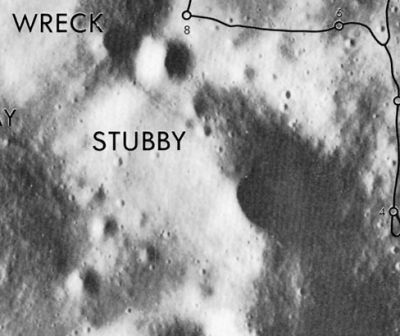Stubby
Contents
[hide]Stubby (Apollo 16 site craterlet name)
|
Lat: 9.1°S, Long: 15.5°E, Diam: 1 km, Depth: km, Rükl: 45 |
Apollo 16 Site Traverses Chart
Images
LPOD Photo Gallery Lunar Orbiter Images Apollo Images Is something of Stubby visible on westward looking photographs made at Apollo 16's Station 4? Perhaps nothing at all, because of the absence of the shadows of this crater's rim. Note: during each one of the six manned lunar landings, westward looking photographs didn't show very much of the slopes of nearby craters and craterlets: the sun was always "behind" the photographer.
The eastern shadowed inner slopes of Stubby are perhaps noticeable on southeast-ward looking photographs made at Station 8...
- DannyCaes Nov 1, 2016
Panorama made by LMP Charles Duke of Stubby crater (Hasselblad frames AS16-112-18260 to 18268) (made at 144:15:43 GET).
According to the ALSJ of E.M.Jones, Stubby is also captured in AS16-110-17954.
Location of Stubby at the base of Stone Mountain, as seen from Spook crater (Station 2)
Maps
(LAC zone 78D2) LAC map Geologic map LM map LTO map Topophotomap 78D2/S1
Description
Apollo 16's LMP Charles Duke, from the 1972 Technical Debrief:
- Stubby was a very old, subdued, tired-looking crater and it wasn't much but regolith. I got pictures of Stubby, but there was no lineation, no evidence of outcrop, no evidence of anything except old, tired-looking things.
Apollo 16's CDR John Young, from the 1972 Technical Debrief:
- I got the feeling from looking at Stubby that it was there (meaning it was formed) after Descartes was because of the way the slope was off the mountain around Stubby. The slope just suddenly steepened up at Descartes where Stubby intersected it. That could be erroneous, but that's the only reasonable conclusion that I could come to. The rim of Stubby bisected - or cut off - some of Stone Mountain.
- One pre-mission hypothesis about Stone Mountain was that the mountain was a relatively recent volcanic construct. If, however, an old crater like Stubby cuts into the mountain, the mountain must be very old. The astronauts all received a great deal of training in the principle of "superposition" - what's on top of what - a key to determining the relative ages of geologic features.
(source: Apollo Lunar Surface Journal - Eric M. Jones, at 144:13:06 GET in the Apollo 16 page Geology Station 4 at the Stone Mountain Cincos).
Description: Wikipedia
(no Wikipedia page for Apollo 16's crater Stubby).
Additional Information
The Landing Site Name "Stone Mountain" is plotted on Site Traverses chart 78D2S2.
Nomenclature
Astronaut-named feature, Apollo 16 site.
LPOD Articles
Bibliography
David M. Harland: EXPLORING THE MOON, the Apollo expeditions.
Eric M. Jones: APOLLO LUNAR SURFACE JOURNAL (ALSJ).
